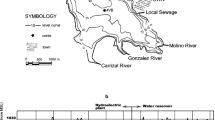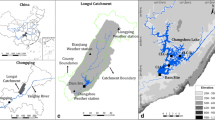Abstract
Watershed land-use changes, including urbanization, have caused accelerated soil erosion, which in turn has increased sediment accumulation rates in most aging reservoirs in the mid-western United States (USA), thereby posing a threat to their longevity and productivity. We analyzed three sediment cores from each of two reservoirs in the mid-western USA, the Webber Dam impoundment in Michigan and Goshen Pond in Indiana. Core chronologies were established using 137Cs and 210Pb. Concentrations of organic carbon and nitrogen and their stable isotope compositions (δ13C and δ15N) were measured to investigate past land-use changes. We used three excess 210Pb-based (210Pbxs) sedimentation rate models (constant 210Pb flux and sedimentation, constant rate of supply of 210Pb and constant initial 210Pb concentration) to develop core chronologies and compared them to the chronology obtained from the 137Cs peak. Validation of the excess 210Pb-based chronology with137Cs-based chronology requires more than one 210Pbxs-based-model. That is, even in one watershed, output from more than one 210Pbxs-based model may have to be compared with an independent time marker. We compared C/N ratios, δ13C and δ15N among three time horizons in each of the three cores from the reservoirs (corresponding to dates of 1950, 1970 and 2010). Within a reservoir, there can be large differences between cores for a given time horizon, indicating there could be spatial differences in sources of C and N and the processes that influence carbon and nitrogen isotopes. We conclude that multiple sediment cores from reservoirs should be analyzed if carbon and nitrogen isotopes in sediments are to be used for paleoenvironmental inference.







Similar content being viewed by others
References
Abril JM, Brunskil GJ (2014) Evidence for excess 210Pb flux varies with sediment accumulation rate and implications for dating recent sediments. J Paleolimnol 52:121–137
Appleby PG, Oldfield F (1992) Application of lead-210 to sedimentation studies. In: Ivanovich M, Harmon RS (eds) Uranium-series disequilibrium: applications to earth, marine and environmental sciences. Clarendon Press, Oxford, pp 731–778
Appleby P, Oldfield F, Thompson R, Huttennen P, Tolonen K (1979) 210Pb dating of annually laminated lake sediments from Finland. Nat (Lond) 280:53–55
Arnaud F, Magand O, Chapron E (2006) Radionuclide dating (210Pb, 137Cs, 241Am) of recent lake sediments in a highly active geodynamic setting (Lakes Puyehue and Icalma e Chilean Lake District). Sci Total Environ 366:837–850
Baskaran M, Coleman CH, Santschi PH (1993) Atmospheric depositional fluxes of 7Be and 210Pb at Galveston and College Station, Texas. J Geophys Res 98:20555–20571
Baskaran M, Nix J, Kuyper C, Karunakara N (2014) Problems with the dating of sediment core using excess 210Pb in a freshwater system impacted by large scale watershed changes. J Environ Radioact 138:355–363
Baskaran M, Miller CJ, Kumar A, Andersen E, Hui J, Selegean JP, Creech CT, Barkach J (2015) Sediment accumulation rates and sediment dynamics using five different methods in a well-constrained impoundment: case study from Union Lake, Michigan. J Gt Lakes Res 41:607–617
Blais JM, Kalff J, Cornett RJ, Evans RD (1995) Evaluation of 210Pb dating in lake sediments using stable Pb, Ambrosia pollen, and 137Cs. J Paleolimnol 13:167–178
Bonotto D, Garcia-Tenorio R (2014) A comparative evaluation of the CF:CS and CRS models in Pb-210 chronological studies applied to hydrodynamic basins in Brazil. Appl Radiat Isot 92:58–72
Conkin PK (2008) A revolution down on the farm. University Press of Kentucky, Lexington
Crusius J, Anderson RF (1995) Sediment focusing in six small lakes inferred from radionuclide profiles. J Paleolimnol 13:143–155
Davis R, Hess C, Norton S, Hanson D, Hogland K, Anderson D (1984) 137Cs and 210Pb dating of sediments from soft-water lakes in New England (U.S.A.) and Scandinavia, a failure of 137Cs dating. Chem Geol 44:151–185
DeMaster DJ, Cochran JK (1982) Particle mixing rates in deep-sea sediments determined from excess 210Pb and 32Si profiles. Earth Planet Sci Lett 61:257–271
Heiri O, Lotter AF, Lemcke G (1999) Loss on ignition as a method for estimating organic and carbonate content in sediments: reproducibility and comparability of results. J Paleolimnol 25:101–110
Hodell DA, Schelske CL (1998) Production, sedimentation, and isotopic composition of organic matter in Lake Ontario. Limnol Oceanogr 43:200–214
Hossain F, Jeyachandran I, Pielke R (2009) Have large dams altered extreme precipitation patterns. Eos Trans Am Geophys Union 48:452–453
Hui J (2014) Methods for estimating sediment yield and dam capacity in the Great Lakes watershed. Wayne State University, Detroit
Hyde CK (1976) The Lower Peninsula of Michigan—an inventory of historic engineering and industrial sites. Wayne State University, Detroit
Jweda J, Baskaran M (2011) Interconnected riverine-lacustrine systems as sedimentary repositories: case study in southeast Michigan using 210Pb and 137Cs-based sediment accumulation and mixing models. J Gt Lakes Res 37:432–446
Jweda J, Baskaran M, Van Hees E, Schweitzer L (2008) Short-lived radionuclides (7Be and 210Pb) as tracers of particle dynamics in a river system in southeast Michigan. Limnol Oceanogr 53:1934–1944
Klaminder J, Appleby D, Crook P, Renberg I (2012) Post-deposition diffusion of 137Cs in lake sediment: implications for radiocesium dating. Sedimentology 59:2259–2267
Mabit L, Benmansour M, Abril JM (2014) Fallout 210Pb as soil and sediment tracer in catchment sediment budget investigations: a review. Earth Sci Rev 138:335–351
MacKenzie AB, Hardie SML, Farmer JG (2011) Analytical and sampling constraints in Pb-210 dating. Sci Total Environ 409:1298–1304
Mayer B, Boyer EW, Goodale C et al (2002) Sources of nitrate in rivers draining sixteen watersheds in the northeastern U.S.: isotopic constraints. Biogeochemistry 57:171–197
Meyers PA (2003) Applications of organic geochemistry to paleolimnological reconstructions: a summary of examples from the Laurentian Great Lakes. Org Geochem 34:261–289
Oldfield F, Appleby P (1984) A combined radiometric and mineral magnetic approach to recent geochronology in lakes affected by catchment disturbance and sediment redistribution. Chem Geol 44:67–83
Pang PC, Nriagu JO (1977) Isotopic variations of nitrogen in Lake Superior. Geochim Cosmochim Acta 41:811–814
Robbins JA, Edgington DN (1975) Determination of recent sedimentation rates in Lake Michigan using Pb-210 and Cs-137. Geochim Cosmochim Acta 39:285–304
Robbins JA, Mudrock A, Oliver BG (1990) Transport and storage of 137Cs and 210Pb in sediments of Lake St. Clair. Can J Fish Aquat Sci 47:572–587
Rose NL (2001) Fly-ash particles. In: Last WM, Smol JP (eds) Tracking environmental change using lake sediments. Kluwer Academic Publishers, Dordrecht, pp 319–349
Routh J, Meyers PA, Gustafsson O, Baskaran M (2004) Sedimentary geochemical characteristics of Lake Brunnsviken, Sweden: a record of human-inducted environmental changes in the watershed. Limnol Oceanogr 49:1560–1569
Routh J, Meyers PA, Hjorth T, Baskaran M, Hallberg R (2007) Sedimentary geochemical record of recent environmental changes around Lake Middle Marviken, Sweden. J Paleolimnol 37:529–545
Sanchez-Cabeza JA, Ruiz-Fernandez AG (2012) 210Pb sediment radiochronology: an integrated formulation and classification of dating tools. Geochim Cosmochim Acta 82:183–200
Sanders CJ, Patchineelam SR, Machado W (2012) Nuclear test fallout signatures in sediments on the Brazillian coast (Pu-240,239 and Cs-137). Quim Nova 35:1209–1212
Smith J (2001) Why should we believe 210Pb geochronologies? J Environ Radioact 55:121–123
Tylmann W, Enters D, Kinder M (2013) Multiple dating of varved sediments from Lake Lazduny, northern Poland: toward an improved chronology for the last 150 years. Quat Geochronol 15:98–107
Von Gunten L, Grosjean M, Beer J (2009) Age modelling of young non-varved sediments: methods and limits. Examples from two lakes in Central Chile. J Paleolimnol 42:401–412
Vreca P, Muri G (2010) Sediment organic matter in mountain lakes of north-western Slovenia and its stable isotopic signatures: records of natural and anthropogenic impacts. Hydrobiologia 648:35–49
Wan GJ, Santschi PH, Sturm M, Farrenkothen K, Lueck A, Werth E, Schuler E, Schuler C (1987) Natural (Pb-210, Be-7) and fallout (Cs-137, Pu-239,240, Sr-90) radionuclides as geochemical tracers of sedimentation in Greifensee, Switzerland. Chem Geol 63:181–196
Woszczyk W, Tylmann W, Jedrasik J (2014) Recent sedimentation dynamics in a shallow coastal lake (Lake Sarbsko, northern Poland): driving factors, processes and effects. Mar Freshw Res 65:1102–1115
Acknowledgments
We thank Robin Heichel for help with sample preparation for stable isotope analysis. We thank John Barkach for assisting us with the sediment core collection. This project was funded by the U.S. Army Corps of Engineers (W911XK-10-C-0011 and W911XK-14-C-0023). We thank the two anonymous reviewers for their in-depth review of our manuscript. We thank Editor Mark Brenner for a thorough editing of the manuscript.
Author information
Authors and Affiliations
Corresponding author
Electronic supplementary material
Below is the link to the electronic supplementary material.
Rights and permissions
About this article
Cite this article
Kumar, A., Hage-Hassan, J., Baskaran, M. et al. Multiple sediment cores from reservoirs are needed to reconstruct recent watershed changes from stable isotopes (δ13C and δ15N) and C/N ratios: case studies from the mid-western United States. J Paleolimnol 56, 15–31 (2016). https://doi.org/10.1007/s10933-016-9888-0
Received:
Accepted:
Published:
Issue Date:
DOI: https://doi.org/10.1007/s10933-016-9888-0




